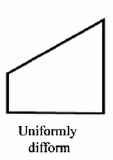by Corry Shores
[Search Blog Here. Index-tags are found on the bottom of the left column.]
[Central Entry Directory]
[Husserl Entry Directory]
No. 5
Enduring Perception as Simple Act
Paragraph 46
If a perception lasts more than a moment, then it is made-up of parts. But it is possible that our awarenesses during each of these moments follow along one continuous single act. Previously Husserl discussed perceptions of things that stay the same over a duration of time. The tone retains its same tonal qualities for a series of moments. Each moment is distinct on account of it falling in a different place along the temporal succession. However, what we perceive in that moment is identically the same as during the other moments. When we think abstractly or conceptually about the tone during any one of the moments, we may find it to be identical with what we hear during the other moments, even though we find them temporally separated.
Now Husserl examines uniform changes in what we perceive. In particular, he refers to a tone "uniformly dying away." So the alteration is uniform. The change of one moment is the same change of another moment, even though the content of one moment is different from the others.
[Consider also Oresme’s latitude of forms. We may depict a uniform change with a shape like this.
(Thanks Jeff Babb)
For each extent along the horizontal axis, there is a uniform change along the vertical axis. So we might compare a horizontal extent of one length with another horizontal extent of the same length. We find that the vertical change will be the same in both cases. Also, we will find that the “instantaneous change” at any point is equal to any other point. So in uniform change, the change itself stays the same, even though what is changing is continually distinct.]
The tone’s change is continuous. So to is our perception of it continuous. And, the correlation between them is continuous. [This seems similar to Aristotle’s continuous correlation of space and time.]
Each enduring perception of the uniform content can be temporally divided, and to each temporal division corresponds a part of the perception. And just as the temporal part of the tone is tone, so the temporal part of the perception is perception. (161bc)
Husserl ends the paragraph writing:
Moreover, the perception in this case not only endures objectively but in addition preserves the character of duration phenomenally, which by no means leaves it entirely unchanged. (161bc)
[I am not certain what he means. We perceive the tone. The tone is changing continuously. But because at each moment there is a tone change, and because each tone change, as a degree of change, is the same each moment, then the content is no longer the identity of the tone, but rather the identity of that sort of change, (for example, the tone fading-out at particular rate of change). Our continuing perception of this one continuous change allows us to take the whole continuum of alteration as one enduring content of our awareness. So the change’s enduring itself is a phenomenon that we are aware-of. But he ends by suggesting that the duration (or its characteristics) might change. Or maybe he means the perception of the duration is what could change. Regardless of what is changing, I do not know why he says this.]


No comments:
Post a Comment